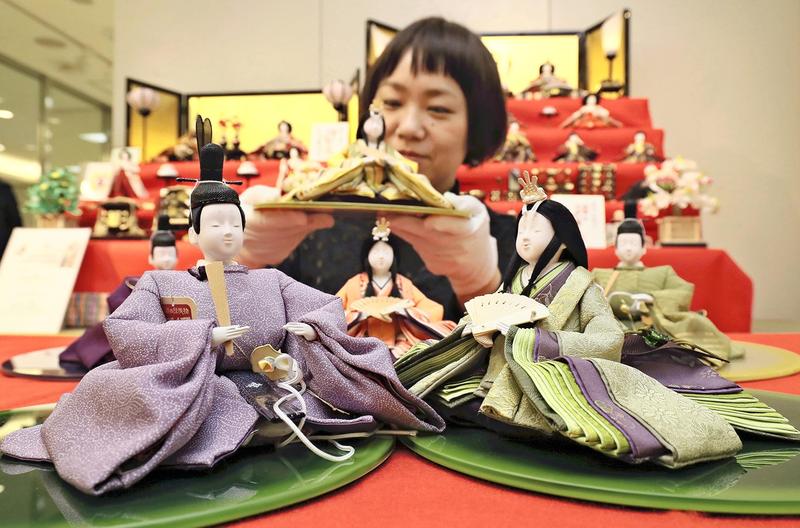 In this undated photo, hina dolls sit on lacquered glass trays at Nihombashi Takashimaya Shopping Center in Tokyo, Japan. (PHOTO / THE JAPAN NEWS)
In this undated photo, hina dolls sit on lacquered glass trays at Nihombashi Takashimaya Shopping Center in Tokyo, Japan. (PHOTO / THE JAPAN NEWS)
TOKYO - March 3 is the Hina Matsuri (Doll Festival), a traditional event of displaying hina dolls to hope for girls’ growth and health. In recent years, there has been a boom among women, who are buying and displaying their own hina dolls or holding parties to celebrate the event.
Three years ago, a 67-year-old part-timer in Nishinomiya, Hyogo Prefecture, bought some hina dolls at a store selling miscellaneous Japanese goods and has displayed them every year since.
“I had my daughter take her set of hina dolls with her when she married. But I still want to display hina dolls whenever this season comes around as they cheer me up,” she said.
Takashimaya department store started selling a set of hina dolls for ¥297,000 (around US$2,700) inclusive of tax for adult customers this year. Yellow and subdued red are used for the kimono worn by the female dolls, while green and light blue are used for the male dolls. Their faces are pretty rather than cute. The relatively small dolls sit on lacquered glass trays instead of the typical pedestals.
Many people buy hina dolls on the occasion of their daughters’ or granddaughters’ first Hina Matsuri, but Takashimay has seen an increasing number of customers — mainly those in their 50s and 60s — who buy the dolls for themselves
“It would suit a Western-style room, too. I want to decorate with this set for myself after I’m done with helping my grandchildren grow up,” a 61-year-old shopper said with a smile as she gazed at the dolls at Nihombashi Takashimaya Shopping Center in January.
ALSO READ: Door to a doll maker's world
Many people buy hina dolls on the occasion of their daughters’ or granddaughters’ first Hina Matsuri. At Takashimaya, however, an increasing number of customers — mainly those in their 50s and 60s — buy the dolls for themselves or as gifts to celebrate their own or their family members’ 60th or 77th birthdays.
Doll designer Yutaka Shimizu, 33, who created the stylish dolls at the Takashima store said: “I made dolls that would suit modern interiors. Their designs are simple, so they’ll be easy to arrange.”
At doll maker Kyugetsu Co, a certain number of people buy their own hina dolls every year.
READ MORE: Japan to celebrate doll festival in March
“Standing dolls and those carved with a single knife are popular,” a Kyugetsu spokesperson said.
Junji Kurakata, vice-chair of the Ningyo-Kyokai doll association, said, “Some people buy them because they didn’t have hina dolls in their childhood, and special booths are set up in some stores.”
Ladies’ get-together
The Hina Matsuri season seems to be a good opportunity for women to get together. Shibuya Excel Hotel Tokyu is offering a “Hina Matsuri” lunch course meal for ¥4,500 (tax and service charge included) at its French restaurant until March 3. The course comes with appetizers inspired by chirashi-zushi (vinegared rice topped or mixed with seafood and other ingredients) and clam chowder, among other seasonal dishes. The hotel said the set is popular among women coming in a group.
The trend of adults celebrating the festival can be described as a ‘return to the original tradition.
Hiroaki Koresawa, Professor at the Otsuma Women's University, Japan
The Tobu department store in Ikebukuro will start selling rose wine, sakura-colored sake and hors d’oeuvres in the food section from Feb 20, in its first attempt to sell Hina Matsuri items targeting adults.
ALSO READ: Iconic Barbie doll celebrates 60 years of evolution
Western confectionery chain HIBIKA, which has stores at Nihombashi Takashimaya Shopping Center in Tokyo and Hankyu Umeda Main Store in Osaka, will sell cakes with sophisticated designs between March 1-3 to attract adult customers.
According to Otsuma Women’s University Professor Hiroaki Koresawa, an expert on hina dolls, back in the Edo period (1603-1867), Hina Matsuri was a festival not only for girls but also for women. In the middle of the Edo period, there was even a tradition in which men gave popular hina dolls to the women in their life as gifts.
“The trend of adults celebrating the festival can be described as a ‘return to the original tradition,’” Koresawa said. “Hina dolls or celebrating the event may be a good opportunity to talk as a family.”
Try your hand
At this time of year, you can find hina dolls displayed everywhere.
“Such regions as Nagoya and Kanazawa where powerful daimyo families dominated preserve many precious hina dolls handed down from old times. It’s worth seeing them,” said journalist Machiko Yorozu, the author of “Nihon no Kyuka Hina Meguri no Tabi” (Visits to old Japanese houses to find hina dolls).
Anyone can enjoy “experiencing” this tradition. Keio Plaza Hotel Tokyo is exhibiting about 6,800 hanging hina doll ornaments in the main lobby until March 26.
This year, the hotel plans to hold workshops for making the ornaments and also offers a class in peach blossom branch arrangement hosted by an ikebana practitioner.



